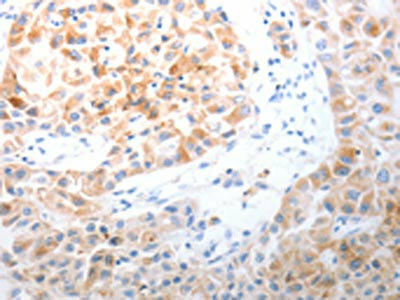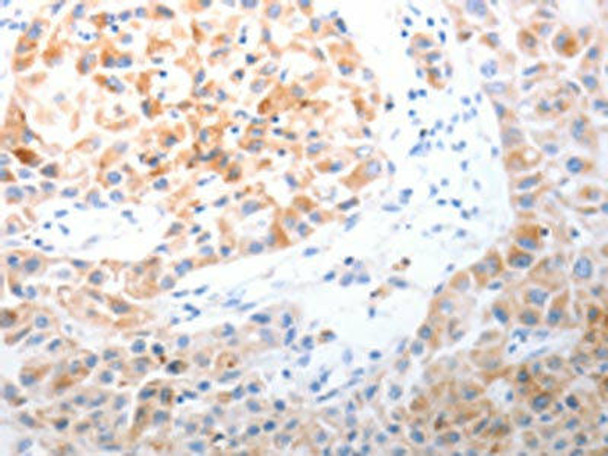Description
| Antibody Name: | LPPR5 Antibody (PACO18811) |
| Antibody SKU: | PACO18811 |
| Size: | 50ul |
| Host Species: | Rabbit |
| Tested Applications: | ELISA, IHC |
| Recommended Dilutions: | ELISA:1:1000-1:2000, IHC:1:15-1:50 |
| Species Reactivity: | Human, Mouse |
| Immunogen: | Synthetic peptide of human LPPR5 |
| Form: | Liquid |
| Storage Buffer: | -20°C, pH7.4 PBS, 0.05% NaN3, 40% Glycerol |
| Purification Method: | Antigen affinity purification |
| Clonality: | Polyclonal |
| Isotype: | IgG |
| Conjugate: | Non-conjugated |
 | The image on the left is immunohistochemistry of paraffin-embedded Human lung cancer tissue using PACO18811(LPPR5 Antibody) at dilution 1/20, on the right is treated with synthetic peptide. (Original magnification: x200). |
| Background: | The protein encoded by this gene is a type 2 member of the phosphatidic acid, phosphatase (PAP) family. All type 2 members of this protein family contain 6 transmembrane regions, and a consensus N-glycosylation site. PAPs convert phosphatidic acid, to diacylglycerol, and function in de novo synthesis of glycerolipids as well as in receptor-activated signal transduction mediated by phospholipase D. Alternate transcriptional splice variants, encoding different isoforms, have been characterized. |
| Synonyms: | Lipid phosphate phosphatase-related protein type 5 |
| UniProt Protein Function: | PAP2D: is a type 2 member of the phosphatidic acid phosphatase (PAP) family. All type 2 members of this protein family contain 6 transmembrane regions, and a consensus N-glycosylation site. PAPs convert phosphatidic acid to diacylglycerol, and function in de novo synthesis of glycerolipids as well as in receptor-activated signal transduction mediated by phospholipase D. Alternate transcriptional splice variants, encoding different isoforms, have been characterized. [provided by RefSeq, Jul 2008] |
| UniProt Protein Details: | Protein type:Hydrolase; Membrane protein, multi-pass; EC 3.1.3.-; Membrane protein, integral Chromosomal Location of Human Ortholog: 1p21.3 Cellular Component: integral to membrane Molecular Function:hydrolase activity Biological Process: metabolic process |
| NCBI Summary: | The protein encoded by this gene is a type 2 member of the phosphatidic acid phosphatase (PAP) family. All type 2 members of this protein family contain 6 transmembrane regions, and a consensus N-glycosylation site. PAPs convert phosphatidic acid to diacylglycerol, and function in de novo synthesis of glycerolipids as well as in receptor-activated signal transduction mediated by phospholipase D. Alternate transcriptional splice variants, encoding different isoforms, have been characterized. [provided by RefSeq, Jul 2008] |
| UniProt Code: | Q32ZL2 |
| NCBI GenInfo Identifier: | 172046620 |
| NCBI Gene ID: | 163404 |
| NCBI Accession: | Q32ZL2.2 |
| UniProt Secondary Accession: | Q32ZL2,Q32ZD0, Q3ZCU7, A8MPX4, B7UCH3, |
| UniProt Related Accession: | Q32ZL2 |
| Molecular Weight: | 321 |
| NCBI Full Name: | Lipid phosphate phosphatase-related protein type 5 |
| NCBI Official Symbol: | LPPR5 |
| NCBI Official Synonym Symbols: | PAP2; PRG5; PAP2D |
| NCBI Protein Information: | lipid phosphate phosphatase-related protein type 5; PRG-5; plasticity-related protein 5; phosphatidic acid phosphatase 2d; plasticity-related gene 5 protein; phosphatidic acid phosphatase type 2 |
| UniProt Protein Name: | Lipid phosphate phosphatase-related protein type 5 |
| UniProt Synonym Protein Names: | Phosphatidic acid phosphatase 2d; Plasticity-related gene 5 protein; PRG-5 |
| UniProt Gene Name: | LPPR5 |
| UniProt Entry Name: | LPPR5_HUMAN |






